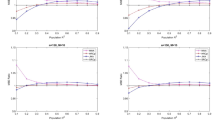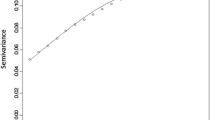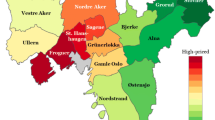Abstract
It is often necessary to accurately predict the price of a house between sales. One method of predicting house values is to use data on the characteristics of the area's housing stock to estimate a hedonic regression, using ordinary least squares (OLS) as the statistical technique. The coefficients of this regression are then used to produce the predicted house prices. However, this procedure ignores a potentially large source of information regarding house prices—the correlations existing between the prices of neighboring houses. The purpose of this article is to show how these correlations can be incorporated when estimating regression coefficients and when predicting house prices. The practical difficulties inherent in using a technique called kriging to predict house prices are discussed. The article concludes with an example of the procedure using multiple listings data from Baltimore.
Similar content being viewed by others
References
Christensen, Ronald. (1991). Linear Models for Multivariate, Time Series, and Spatial Data (pp. 288-292). New York: Springer-Verlag.
Cressie, Noel. (1984). “Towards Resistant Geostatistics.” In G. Verly et al., (eds.), Geostatistics for Natural Resources Characterization, part 1 (pp. 21-44). Amsterdam: Reidel.
Cressie, Noel. (1988). “Spatial Prediction and Ordinary Kriging,” Mathematical Geology 20, 405-421.
Dubin, Robin. (1992). “Spatial Autocorrelation and Neighborhood Quality”, Regional Science and Urban Economics 22, 433-452.
Dubin, Robin. (1994). “Estimating Correlograms: A Monte Carlo Study”, Geographical Systems 1, 189-202.
Goldberger, Arthur. (1968). Topics in Regression Analysis (pp. 118-122). New York: McMillan.
Judge, George, W. E. Griffiths, R. Carter Hill, et al. (1985). The Theory and Practice of Econometrics (2nd ed.) (pp. 315-316). New York: Wiley.
Ripley, Brian. (1981). Spatial Statistics. New York: Wiley.
Strange, William. (1992). “Overlapping Neighborhoods and Housing Externalities,” Jourrnal of Urban Economics 32, 17-39.
U.S. Bureau of the Census. (1992). “1990 Census of Population and Housing Data Paper Listing” (CPH-L-121). Washington, DC: U.S. Government Printing Office.
Author information
Authors and Affiliations
Rights and permissions
About this article
Cite this article
Dubin, R.A. Predicting House Prices Using Multiple Listings Data. The Journal of Real Estate Finance and Economics 17, 35–59 (1998). https://doi.org/10.1023/A:1007751112669
Issue Date:
DOI: https://doi.org/10.1023/A:1007751112669




